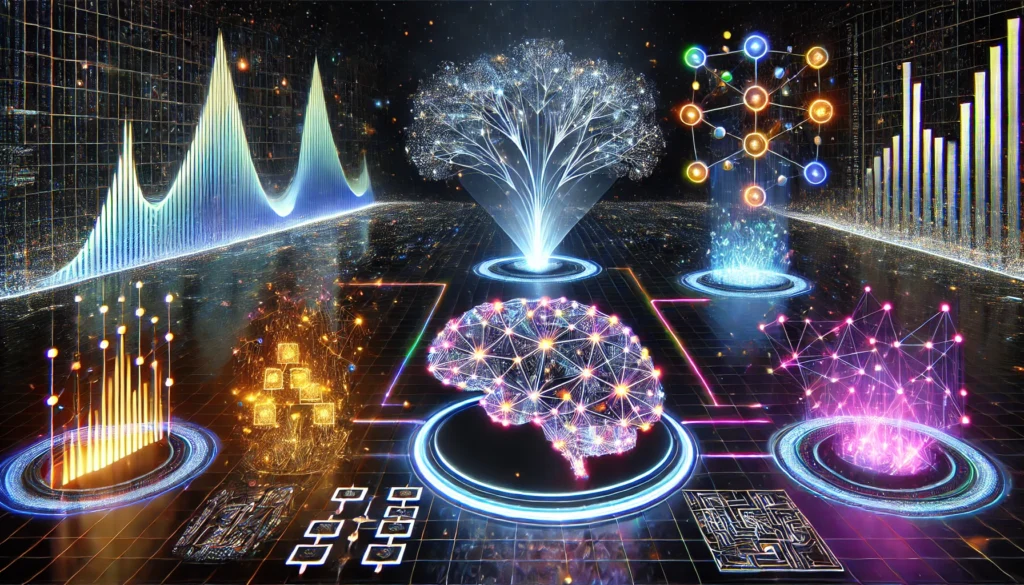Machine learning is revolutionizing the tech industry, and various machine learning techniques are driving this change. These techniques allow machines to learn from data and make decisions with minimal human intervention. In this guide, we’ll delve into the different types of machine learning methods, their applications, and how they function.

What Are Machine Learning Techniques?
Machine learning techniques means algorithms and methods machines use to learn patterns from data. These techniques fall under different categories, each focusing on specific types of problems. The primary aim of machine learning techniques is to enable machines to make predictions, classifications, or decisions based on data.
The Three Key Approaches to Machine Learning Techniques.
There are three broad categories of machine learning techniques:
- Supervised Learning:
In supervised learning, algorithms are trained on labeled data, where the outcome is already known. The system learns from this data and can then make predictions on new, unseen data. Standard algorithms include Linear Regression, Decision Trees, and Support Vector Machines (SVM). - Unsupervised Learning:
Unsupervised learning uses unlabeled data. The algorithm tries to find hidden patterns or groupings in the data. It is often used in clustering and association problems. Widely recognized algorithms in this field, such as K-means clustering and hierarchical clustering, offer powerful tools for data analysis and insight extraction. - Reinforcement Learning:
In reinforcement learning, an agent learns by interacting with its environment. The agent receives rewards or penalties based on its actions. This approach is commonly applied in robotics, gaming, and autonomous systems. Q-learning and Deep Q-Networks (DQN) are key algorithms in this field.

Key Machine Learning Algorithms to Know
1. Linear Regression
Linear regression is among the most straightforward machine-learning techniques. It models the relationship between a dependent variable and one or more independent variables. It’s widely used in prediction tasks where the output is continuous, such as predicting house prices or sales forecasts.
2. Decision Trees
Decision trees are a type of supervised learning technique that splits data into subsets based on feature values. They are easy to interpret and visualize, making them useful for classification and regression tasks. Decision trees work by creating a flowchart-like structure to represent decisions and their possible consequences.
3. K-means Clustering
K-means clustering is an unsupervised learning method that divides a dataset into groups based on similarity. Each cluster has a center point called the centroid, and data points are assigned to the cluster with the nearest centroid. This technique is widely used in customer segmentation and pattern recognition.
4. Neural Networks
Neural networks are inspired by the human brain. These complex models are used in supervised and unsupervised learning tasks. The network consists of layers of nodes (neurons) that work together to process data. Deep learning, a subset of machine learning, uses large neural networks to analyze huge datasets for tasks such as image recognition and natural language processing (NLP).
5. Support Vector Machines (SVM)
Support Vector Machines are powerful classifiers that work by finding the optimal hyperplane that best separates different classes of data. Support Vector Machines (SVM) are commonly used for classification tasks, including spam detection and image classification.

Applications of Various Machine Learning Techniques
Machine learning spans multiple industries, with a wide range of applications for various techniques:
- Healthcare: Machine learning techniques help in diagnosing diseases, predicting patient outcomes, and personalizing treatment plans.
- Finance: Fraud detection, credit scoring, and algorithmic trading benefit from machine learning algorithms.
- Retail: Recommendation systems and demand forecasting are powered by machine learning techniques.
- Transportation: Self-driving cars and route optimization rely on reinforcement learning and other machine learning methods.
Benefits of Using Machine Learning Techniques
- Automation: Machine learning techniques automate complex tasks, saving time and reducing human error.
- Improved Accuracy: Algorithms can process large datasets quickly and provide insights that humans might miss.
- Cost Efficiency: By automating processes, businesses can reduce operational costs while improving efficiency.
- Personalization: Machine learning allows for highly personalized customer experiences in industries like e-commerce and entertainment.

Challenges with Machine Learning Techniques
While machine learning techniques offer immense potential, they also come with challenges:
- Data Quality: Machine learning algorithms require high-quality data to function effectively. Inaccurate predictions can result from poor or incomplete data.
- Computational Power: Some machine learning techniques and profound learning models require significant computational resources.
- Overfitting: When a model becomes too complex, it may perform well on training data but fail on new, unseen data. Balancing model complexity is crucial.
How to Choose the Right Machine Learning Technique
Choosing the right machine learning technique depends on several factors, including the type of data, the problem you’re trying to solve, and the resources available. For example, if you’re working with large datasets and need high accuracy, deep learning may be the best choice. However, for simpler problems, algorithms like linear regression or decision trees may suffice.
Conclusion
The field of machine learning is vast, with various machine learning techniques enabling advances across multiple industries. Understanding these techniques allows businesses to make better decisions, automate tasks, and unlock insights from data. Whether you are dealing with supervised, unsupervised, or reinforcement learning, each method offers unique benefits and challenges. By selecting the appropriate algorithm for the task at hand, organizations can harness the true power of machine learning and create smarter, more efficient systems.
FAQs About Various Machine Learning Techniques
Q: What is the main difference between supervised and unsupervised learning?
Supervised learning uses labeled data to train models, whereas unsupervised learning works with unlabeled data to find hidden patterns or groupings.
Q: How does reinforcement learning work?
Reinforcement learning involves an agent that interacts with an environment, making decisions based on feedback (rewards or penalties) to maximize cumulative rewards.
Q: What are the common machine learning algorithms used in supervised learning?
Common supervised learning algorithms include Linear Regression, Decision Trees, Support Vector Machines (SVM), and K-Nearest Neighbors (KNN).
Q: Can machine learning techniques be applied in real-time applications?
Yes, machine learning techniques are used in real-time applications like self-driving cars, fraud detection, and recommendation systems.
Q: What are the benefits of using deep learning models?
Deep learning models are particularly effective in handling large datasets and complex tasks, such as image recognition, speech processing, and natural language understanding.


